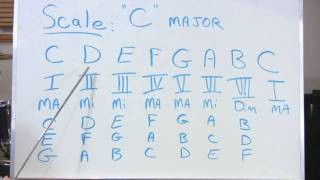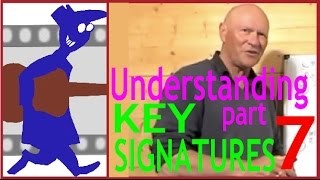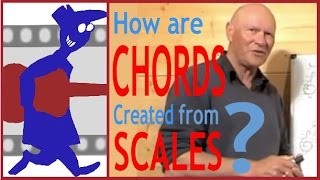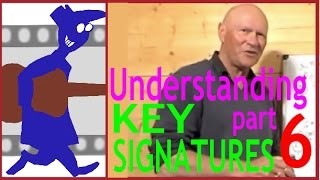There is only one chord shape on the guitar - Part 1
Published on 26 January 2016
If you would like to gain full access to all our Guitar Teaching Materials please visit the Secret Guitar Teacher Site and take a free tour: http://www.secretguitarteacher.com/youtube/ssb.php?lp_id=428
Here is the video transcript:
Because of the combined effect of what I call the second string tuning anomaly and the non-linear arrangement of notes in the Major scale - almost all patterns on the Fret board appear to be more complicated than they really are.
In this little lesson I want to attempt to reveal some of the simplicity behind chord shapes in particular.
Let's start with the chord that many of us probably learn first on the guitar - the G chord. Using what we learnt in the last Sound Bite, in this chord we can easily spot the third interval here between the 6th and fifth strings. But there's actually another slightly hidden third here between the third and second string.
There's an inverted fifth shape here between the open G string and D string...
...remember, think of open notes as being fingered here behind the nut to help see how they fit into the pattern.
Sometimes you might add an extra fifth to the basic G chord to brighten up the sound like this...this is simply another voicing of the same chord - we're trading in a third - B and adding a 5th D.
Again you can spot the fifth interval pattern here distorted slightly by the
second string tuning anomaly and you can also see the inverted fifth shape here between the G fret 3 on the top string and the D fret 3 on the second string.
Now remember that most pairs of adjacent strings on the guitar are tuned a fourth apart E fg A bc D ef G then we have the exception G a B - only a 3rd apart. Then B cd E returning to the fourth interval gap between the top two strings.
So what happens when we take our G chord and move it straight across the strings like this? Well we get a lovely C Maj 7 chord!
So why, when we have moved our fingers up a fourth, by shifting across the fret board don't we simply get a C Major chord?
Well, of course, we have bumped into the second string tuning anomaly again and to compensate for the fact that the gap between the second and third string is only a 3rd instead of a fourth we have to make a fingering adjustment - a fact further concealed by the open strings involved. On the G chord we had the open G in play here but as we shift across we need to move this note up a fret and it becomes a C.
Notice that also, the option of doubling up on the 5th presents itself and just as we could change the third B to the 5th D in the G chord. We can now change the 3rd (in this case E) up to the 5th G by using this fingering and again this gives us a brighter voicing of the chord. We can also roll this G note off the top here round to the bottom E string here and we have the option of putting it into the bass on the C chord to create a second inversion C or use it in an alternating 1 5 bass motif like this maybe.
Now let's look at what happens when we move the C across the strings.
We get quite a discordant sounding chord that we could call an F Maj b5.
Of course we know what to do this time - simply correct for the tuning anomaly problem by taking the note that was on an open string in the C chord, and shifting it up a fret to compensate as the note migrates from 3rd string to second string. Now we can easily recognise this as our bog standard F chord shape. As with the C chord we have the option of converting a third - open A in this case into a fifth - by fingering the A string at the third fret.
Notice also that what goes for the top E string fretted here at the first fret can be brought round to the bottom E string. 'As above, so below' to borrow a saying from metaphysics!
So maybe you are beginning to see what I meant by the title of this sound bite! There really is only one chord shape. Wait! I hear you say, what about E, A, D, B and Bb chords ...?
Well I am going to leave that question for you to explore and show you my answers in the next Sound Bite - see if you can figure it out before then!
 Wah Pedal Guitar Lesson With Michael Casswell | Li...
Wah Pedal Guitar Lesson With Michael Casswell | Li...
 Music Theory - Harmonizing the Major Scale
Music Theory - Harmonizing the Major Scale
 GUITAR THEORY: Constructing Chords on the Guitar N...
GUITAR THEORY: Constructing Chords on the Guitar N...
 Relative Keys
Relative Keys
 Marty Schwartz Guitar Solo Lesson - Solo Concepts...
Marty Schwartz Guitar Solo Lesson - Solo Concepts...
 There is only one chord shape on the guitar - Part...
There is only one chord shape on the guitar - Part...
 Diminished Chords - How to Play them on the Guitar...
Diminished Chords - How to Play them on the Guitar...
 GUITAR THEORY: Voicing 7th Chords and Beyond
GUITAR THEORY: Voicing 7th Chords and Beyond
 Understanding Key Signatures - Part 7
Understanding Key Signatures - Part 7
 Jimi Hendrix Style Double-Stop Embellishments
Jimi Hendrix Style Double-Stop Embellishments






